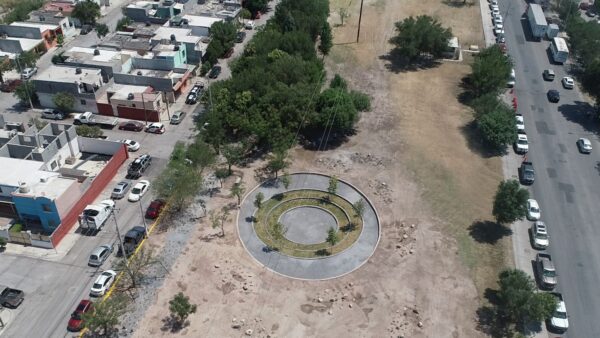On 15th of April 2023, the pilot project in Piura celebrated the start of the constructions of the planned public park in the human settlement 18 de Mayo together with the surrounding residents. Three days afterwards, the Piura City Lab presented the project results at the University of Piura to the municipality, faculty members and the interested public. Globally cities are undergoing significant transformations and are facing substantial challenges due to climate change and rapid urbanization. The MGI pilot in Piura contributes to innovative, low-emission and environmentally friendly urban development in the city.
CLIMATE CONSCIOUSNESS FOR A LONG-TERM EFFECT

Planting trees, painting and reducing plastic consumption: The celebration of the start of the constructions of the MGI pilot in the 18 de Mayo neighborhood was all about climate consciousness. As the project concerns transforming a small illegal dumpsite in the area into a recreational park, having the local habitants on board is key for making sure the sustainable transformation has a long term effect in the community. The goal of this event was to highlight how every person is important for keeping the public space in a good state.
For that, the local team of MGI together with the provincial municipality of Piura engaged the residents in an educational ecology workshop, for example about how to reduce personal plastic consumption, and gave away plants for the neighbors to crop them in the park once it is finished. The children were invited to make drawings about what they had learned in the workshop and share them with their parents.
A STEP FORWARD IN PIURA’S SUsTAINABLE DEVELOPMENT

On 18th of May, the pilot projects results were presented to the municipality in the University of Piura. In his welcome speech, Jorge Machacuay Dean of the Faculty of Engineering of the University of Piura remarked how the MGI pilot has contributed to bringing Piura’s sustainable development forward: “This global initiative is a step towards the smart and urban development of Piura as it proposes solutions for climate change adaptation and efficient use of resources through collaborative design”, he said.
In addition, he recognized how the City Profile analysis conducted by the MGI City Lab has conceptualized priority areas and project ideas to achieve Piura’s sustainability. The profile is a diagnosis elaborated through indicators and interviews with more than 30 local experts in the water, urbanism and energy sectors.
Piura has Great Potential in Solar Energy

City Lab Leader Trinidad Fernández commented on the process the MGI pilot has undergone in the City Lab in Piura. The City Lab approach is a methodology that assesses the status quo in an integrated planning process and a holistic analysis of the city, and identifies key opportunities and risks, taking into account social, economic and environmental factors.
Piura is a city with rapid urban growth that has made it environmentally sensitive, given that the population has expanded into areas exposed to climatic phenomena. In order to understand what is happening in the city, the City Profile has been developed through expert interviews and workshops.
The analysis was developed in four stages: an initial review, quantitative and qualitative assessment of the urban system, identification of measures to be taken, and a project roadmap, Fernandez said.
The analysis also made clear that there are factors in the city that cannot be influenced or changed, such as geography. However, there are several aspects that can be modified to combat climate change, such as quality public spaces, native vegetation, infrastructure planning that integrates adequate water resource management and river integration. Especially in the case of energy there is a great opportunity to use sun and heat, which can serve for an equitable and sustainable energy supply for all, according to Ms. Fernández.
Understanding local level impact of sustainable transformation

Stella Schroeder, Local City Lab Coordinator, presented the pilot project and the collaborative activities that had been carried out. For the pilot, the neighborhood 18 de Mayo was chosen to understand the local level impact of the pilot in its three sustainability pillars (social, environmental and economic). Accordingly, the design of the pilot has been developed with different components: the use of the geographic information system GIS, the transformation of the space, and the component of citizen participation and the continuity of this project.
Share this post with your network!
More from MGI

MGI Says Goodbye
The Morgenstadt Global Smart Cities Initiative (MGI) has been officially concluded. For the occasion, the MGI consortium looks back at four years of transforming cities for the future.

Piura Pilot Project: Transforming a neglected public space
After implementing the MGI pilot project, the residents can now use a formely neglected public space according to their requirements. Read more.

Saltillo Pilot Project offers Solutions to Floodings and Heat
The pilot project of MGI in Saltillo has been successfully implemented. The newly inaugurated park offers solutions to floodings, heat, and biodiversity loss.

